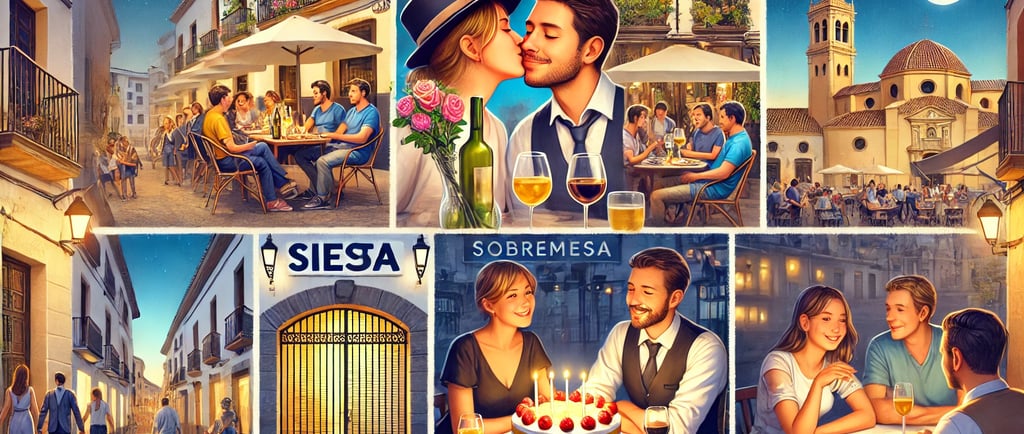5 Spanish Customs You Probably Didn’t Know About
Spain is often associated with siestas, flamenco, and tapas, but there's so much more to Spanish culture than meets the eye. Beneath its vibrant cities and sunny beaches lie deeply rooted customs that reflect centuries of tradition, regional pride, and a unique way of living. Whether you're planning a visit, moving to Spain, or simply curious about how locals live, here are five Spanish customs that might surprise you—and make you fall even more in love with the country
CANNABIS GUIDE
4/15/20253 min read


1. Having Dinner at 10 PM Is Totally Normal
If you're used to eating dinner around 6 or 7 PM, prepare for a cultural shift in Spain. The Spanish dinner hour typically starts around 9 or 10 PM, and it's not considered late at all. In fact, restaurants don’t even open for dinner until 8 PM in many cities.
This schedule stems partly from Spain’s unique time zone (it’s geographically aligned with the UK but follows Central European Time), and partly from its social nature—dinner is seen as a relaxed, unhurried time to catch up with friends or family.
Tip: When in Spain, adjust your eating times gradually. Join locals for a late-night tapas crawl—it’s a social ritual, not just a meal.
2. Two Kisses: The Standard Greeting
In Spain, it’s customary to greet both friends and new acquaintances with two kisses on the cheeks—one on each side. This applies to both men and women, although men usually greet other men with a handshake unless they’re family or very close friends.
This custom is so ingrained that even business or formal introductions may start with kisses if the atmosphere is friendly. Don’t worry—these kisses are air kisses, just brushing cheeks.
Tip: Always start with the right cheek (their left). It feels awkward at first, but you’ll quickly get the hang of it.
3. Everything Stops for La Siesta (Kind Of)
The famous Spanish siesta is real—but it’s not exactly what you think. While the idea of everyone napping after lunch may be a bit outdated, the midday break is still a strong cultural norm, especially in smaller towns.
From around 2 PM to 5 PM, many businesses, shops, and even offices close. People go home for lunch, relax with their families, and enjoy a slower pace before returning to work in the evening.
In cities, siesta culture is less visible due to modern work schedules, but you’ll still find many local shops and restaurants taking long lunch breaks.
Tip: Don’t plan shopping during siesta hours, especially outside major cities.
4. Celebrating Name Days (Santos)
In Spain, your “santo” (saint’s day) can be as important as your birthday. Every day on the Catholic calendar is associated with a saint, and if your name matches the saint of the day, you’ll likely receive calls, messages, and even small gifts from friends and family.
This tradition is more prevalent in older generations or religious families, but it’s still widely recognized. For example, someone named Carmen will be celebrated on July 16, the feast day of Our Lady of Mount Carmel.
Tip: If you're living in Spain, check your calendar and see when your santo is—it might become your second birthday.
5. The Art of the “Sobremesa”
One of the most cherished customs in Spain is the sobremesa, which literally means “over the table.” It refers to the time spent sitting at the table after a meal, talking, laughing, and simply enjoying each other's company—often for an hour or more.
In Spanish culture, meals are not rushed affairs. They're moments to connect, reflect, and be present. Even in restaurants, it’s rare for the waitstaff to bring the check unless you ask for it. The sobremesa is sacred.
Tip: Don’t rush to leave after eating. Instead, order a coffee or a small drink and soak in the atmosphere—this is where the best conversations happen.
Final Thoughts: Embrace the Unexpected
Spanish customs may seem surprising at first, but they reflect a culture built around connection, community, and enjoying life at a slower, more meaningful pace. Whether you're adjusting to late-night dinners or joining in for a spontaneous sobremesa, embracing these customs will enrich your experience in Spain—and maybe even change how you approach life.
So next time you’re in Spain, kiss hello, linger at the table, and don’t be surprised if no one’s in a hurry. That’s just the Spanish way
